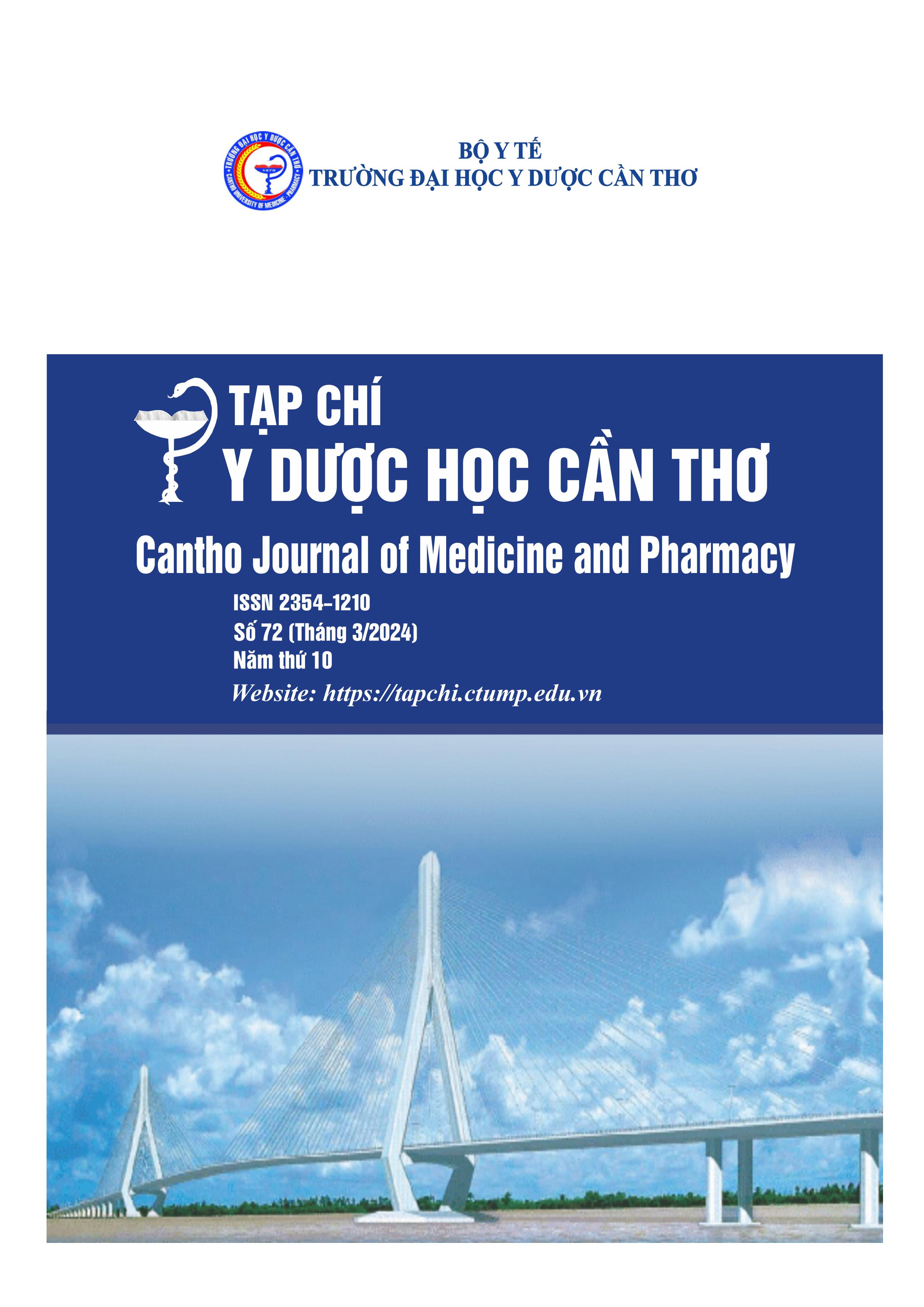CLINICAL, SUBCLINICAL CHARACTERISTICS AND MICROBIAL AGENT CAUSING PEDIATRIC ACUTE DIARRHEA WITH NO DEHYDRATION IN CAN THO
Main Article Content
Abstract
Background: Acute diarrhea is one of the leading causes of death in children, especially children under 5 years old. Real-time PCR has the ability to quickly and accurately identify microbiological agents that cause diarrhea. Objective: To describe some clinical and paraclinical characteristics and determine the rate of microbiological agents causing pediatric acute diarrhea with no dehydration at Can Tho Children's Hospital. Materials and methods: Cross-sectional descriptive study of 119 pediatric cases of acute diarrhea with no dehydration. Results: The disease was common in children under 24 months of age (84.9%). Male (56.3%) had the disease more often than female (43.7%). Common clinical symptoms included fever (80.7%), vomiting (69.8%), and anal diaper rash (60.5%). Most cases had white blood cell index and hematocrit within normal limits. Real-time PCR was capable of detecting microbiological agents up to 84.9%. Viruses were identified as the most common cause of diarrhea (68.1%). The leading agent was Rotavirus (47.1%), followed by Escherichia coli (28.6%), Campylobacter coli (10.1%), Adenovirus (9.3%), Salmonella sp (8.4%) and Shigella species (8.4%). Conclusions: Acute diarrhea with no dehydration was common in children under 24 months of age, with fever and vomiting being two common symptoms. Real-time PCR had a high ability to detect microbiological agents that cause pediatric acute diarrhea with no dehydration. Viruses were the most common causes of diarrhea, the leading being Rotavirus. Therefore, antibiotics are not the primary treatment for acute non-dehydrating diarrhea; and Rotavirus prevention for children is still extremely important.
Article Details
Keywords
Acute diarrhea, no dehydration, children, Can Tho
References
2. UNICEF WHO, The World Bank. Levels & Trends in Child Mortality. UNICEF, New York; WHO, Geneva; The World Bank, Washing-ton, DC, 2012.
3. Hoàng Ngọc Anh, Đặng Thị Thuý Hà, Lương Thị Nghiêm. Đặc điểm lâm sàng, cận lâm sàng của bệnh nhi tiêu chảy cấp tại Bệnh viện Nhi Trung ương. Tạp Chí Nghiên cứu và Thực hành Nhi khoa. 2020. 4(2), 35- 40.
4. Nguyễn Thị Thu Cúc. Khảo sát các tác nhân vi khuẩn của bệnh tiêu chảy ở trẻ em tại khoa
Nhiễm Bệnh viện Nhi Đồng Cần Thơ từ tháng 7/2010 đến tháng 6/2011, Đề tài Nghiên cứu Khoa học, Trường Đại học Y Dược Cần Thơ. 2011.
5. Bin Mohanna, Mabrook Aidah, Al-Sonboli, et al. Prevalence of Diarrhoea and Related Risk Factors among Children Aged Under 5 years in Sana'a. Yemen. 2018. 11(1), 29-33.
6. Harb A., S. Abraham, B. Rusdi, et al. Molecular Detection and Epidemiological Features of Selected Bacterial, Viral, and Parasitic Enteropathogens in Stool Specimens from Children with Acute Diarrhea in Thi-Qar Governorate, Iraq. Int J Environ Res Public Health. 2019. 16(9), 1573, doi: 10.3390/ijerph16091573.
7. Imanadhia Ashfahani, I. G. M. Reza Gunadi Ranuh, Djohar Nuswantoro. Etiology Based on Clinical Manifestation of Acute Diarrhea Incidence of Children Hospitalized in Dr. Soetomo General Hospital Surabaya Period 2011-2013. Biomolecular and Health Science Journal. 2019. 2(1), 31-35.
8. Nguyễn Văn Thiện. Đánh giá tình hình sử dụng thuốc điều trị tiêu chảy ở bệnh nhi nội trú ở Bệnh viện Đa khoa tỉnh Tây Ninh năm 2020. Luận văn Thạc sĩ Dược học, Đại học Tây Đô. 2022.
9. Shah G. S., B. K. Das, S. Kumar, et al. Acid base and electrolyte disturbance in diarrhoea. Kathmandu Univ Med J (KUMJ). 2007. 5(1), 60-62.
10. Nguyễn Thị Mai Hương,Nguyễn Thị Việt Hà. Đặc điểm lâm sàng, cận lâm sàng tiêu chảy cấp phân máu ở trẻ em tại Bệnh viện Đa khoa Đức Giang. Tạp chí Y học Việt Nam. 2021. 505(1).
11. Kabayiza J. C., M. E. Andersson, S. Nilsson, et al. Diarrhoeagenic microbes by real-time PCR in Rwandan children under 5 years of age with acute gastroenteritis. Clin Microbiol Infect. 2014. 20(12), O1128-35, doi: 10.1111/1469-0691.12698.
12. Kabayiza J. C., M. E. Andersson, S. Nilsson, et al. Real-time PCR identification of agents causing diarrhea in Rwandan children less than 5 years of age. Pediatr Infect Dis J. 2014. 33(10), 1037-1042, doi: 10.1097/INF.0000000000000448.
13. Nguyễn Quốc Tính,Nguyễn Thị Cự. Đặc điểm bệnh tiêu chảy cấp do Rotavirus tại Khoa Nhi - Bệnh viện Đa khoa tỉnh Bình Định. Tạp chí Y Dược học - Trường Đại học Y Dược Huế. 2013. 3(5), 50-56.
14. Burnett E., C. L. Jonesteller, J. E. Tate, et al. Global Impact of Rotavirus Vaccination on Childhood Hospitalizations and Mortality From Diarrhea. J Infect Dis. 2017. 215(11), 16661672, doi: 10.1093/infdis/jix186.


